The Autograph Edition of The Writings of Mark Twain provides a basis of comparison for subsequent, and often less expensive, editions. It is the foundation upon which later editions were built into the 20th century. The Autograph Edition was limited to 512 sets. The size of the pages were 8vo.(8.5" x 6.0"). Each volume was numbered on the spine and each volume featured a flyleaf identifying the edition.
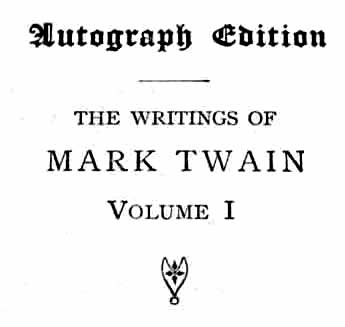
Autograph Edition
flyleaf statement
 Photo courtesy of the Mark Twain Project, Univ. of California at Berkeley |
Each
volume in the set had the limitation statement hand numbered in red ink.
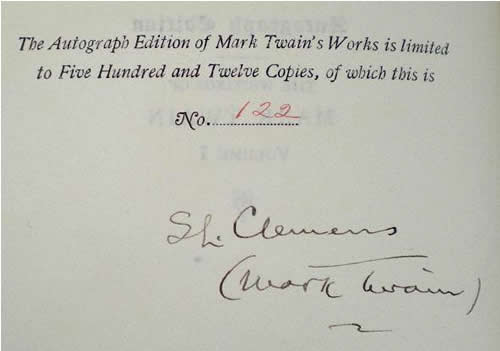 The back of the flyleaf featured the dual signature of S. L. Clemens (Mark Twain) in Volume 1. |
Volume 1, The Innocents Abroad, was signed by Clemens. Brander Matthews signed his introduction which was titled "Biographical Criticism." Charles Dudley Warner, co-author of The Gilded Age, autographed Volume 10. New artwork had been commissioned and various artists signed their illustrations. Illustrations were black and white on coated paper and were protected with tissue guards with printed red captions. Early subscribers to the set were offered one of several special hand-colored illustrations identical to a black and white illustration. The existence of the hand-colored illustrations raises the question of whether or not American Publishing Company had contemplated binding them into the Autograph Edition but later decided against it. The hand-colored illustrations later became a feature of the 1901 Riverdale Edition.
Each individual title in the Autograph Edition contains a different frontispiece portrait of Mark Twain depicting him at the time of each work. Titles that had been divided into two volumes feature the portrait in the first volume.
Sold by subscription, buyers had the opportunity to choose their own bindings. Choices included red full leather; three-quarter leather; marble boards bound in leather; spines with gilt lettering; and buckram cloth with paper labels. Top edges of pages are gilt; side and bottom edges are deckled or ragged. Original leather bindings of these editions did not age well. Sets originally bound in buckram cloth with paper labels on their spine have endured the test of time better than those bound in leather.
| Special paper with the Clemens watermark is a unique and distinguishing characteristic of the first 23 volumes of the Autograph Edition. Volumes 24 - 25, issued by Harper and Brothers, were printed on paper watermarked Old Stratford. |  The Clemens watermark |
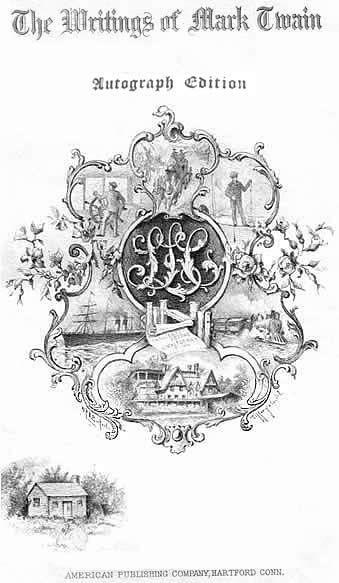 Title page by Tiffany |
A special title page monogram designed by Tiffany and Company and engraved by W. H. W. Bicknell is a distinguishing characteristic of the Autograph Edition, Author's De Luxe Edition, Edition De Luxe, Japan Edition, and Royal Edition. This page appears in each volume of these sets. It features an SLC monogram surrounded by scenes from Mark Twain's life including a boat, stagecoach, train, and his home in Hartford, Connecticut. The lower left corner features a cabin depicting his humble birthplace in Florida, Missouri. Less expensive editions such as Underwood, Riverdale, and Hillcrest feature the Tiffany title page in Volume 1 only. It was eliminated altogether from the Author's National Edition. The original printing plate of this engraving is in the Kevin Mac Donnell collection. |
One or more leaves of manuscript, a Mark Twain letter from Frank Bliss's files, or several of these items would be bound into one or more volumes of the set. Manuscript pages from The Gilded Age are the most often found specimens that were sold in this manner. Auction records for rare book sales for the year 1919 also record the presence of manuscript pages of "How the Chimney Sweep got the Ear of the Emperor" present in a set of the Autograph Edition (American Book Prices Current, 1919, p. 169). According to the editors of the Mark Twain Project at the University of California at Berkeley each set of the Autograph Edition includes a leaf signed by Clemens bound into the Volume 1 (The Innocents Abroad, Part 1) and one or more leaves of manuscript (sometimes a letter, sometimes leaves from a literary work) tipped into one or more volumes of the set.
The practice of binding separate manuscript pages and dispersing them throughout the country has made it almost impossible for today's scholars to accurately reconstruct the composition process of some of Mark Twain's works. At the time, however, the publisher as well as Clemens were focusing on sales rather than historical research a century in the future.
The Mark Twain Project at the University of California at Berkeley has identified the following Autograph Edition sets as containing original letters including the following:
Volume 1 of set 163 - letter from Clemens to Elisha Bliss, Jr. dated 14 February 1869
Volume 23 of set 163 - letter from Clemens to Elisha Bliss, Jr. dated 23 June 1868
Volume 1 of set 272 - letter from Clemens to Elisha Bliss, Jr. dated 10 July 1871
Volume 23 of set 272 - letter from Clemens to Elisha Bliss, Jr. dated 27 August 1875
Based on this pattern, it appears that in 1903 Frank Bliss offered buyers of the Autograph Edition of Volume 23 another chance to acquire original letters or manuscript leaves from his files.
The average price of the Autograph Edition was $200. Calculating for inflation, that price would be the equivalent of over $5,000 in year 2007. The Autograph Edition was not affordable to any but the most wealthy book buyers of the early 20th century and did not sell out quickly.
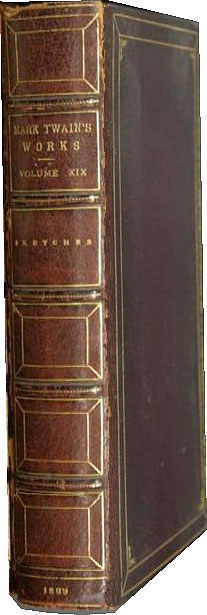 |
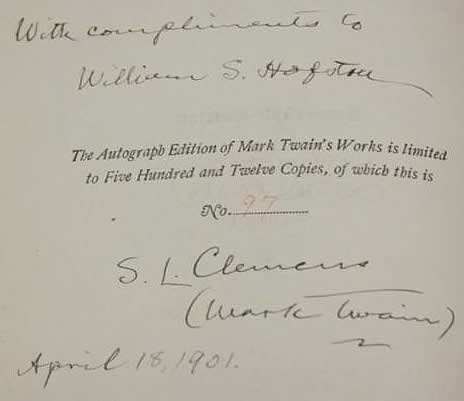 Autograph Edition featuring a personal inscription dated April 18, 1901 for set number 97 to William S. Hofstra indicates the sales of the Autograph Edition, released in 1899, were slow. |
By October 1901, American Publishing Company had teamed up with the Robert G. Newbegin Company to sell the Autograph Edition. The following ad appeared in The Literary Collector in October 1901 and ran for five months.
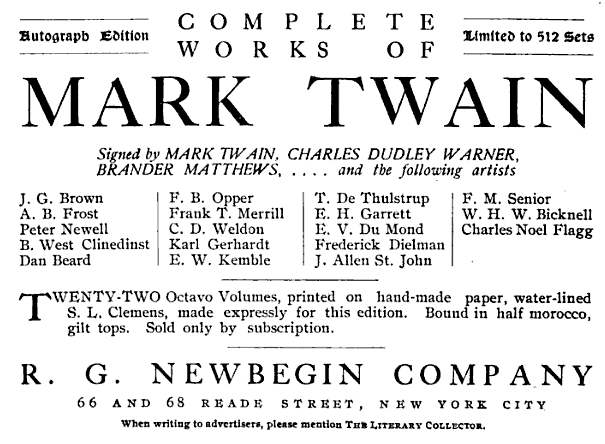
Ad from The
Literary Collector, October 1901
_____
Summary of Features of Autograph Edition
This set establishes a standard of comparison for number of illustrations in other uniform editions. As later editions evolved from this set, the number of illustrations were reduced as prices were lowered. Some key illustrations became virtually unknown to many scholars.
_____
References
American Book Prices Current, Vol. 25. (E. P. Dutton and Company, 1919). Online via google books.
Johnson, Merle. A Bibliography of the Works of Mark Twain. (Harper and Brothers, 1935).
The Literary Collector, Vol. 3, October 1901 - March 1902. Online via google books.
Mac Donnell, Kevin. Personal correspondence, 19 April 2009.
Mac Donnell, Kevin. Personal correspondence, 28 January 2010.
Mark Twain Project. Online database of letters and textual commentary at: http://www.marktwainproject.org
Rodney, Robert M. Mark Twain International. (Greenwood Press, 1982).